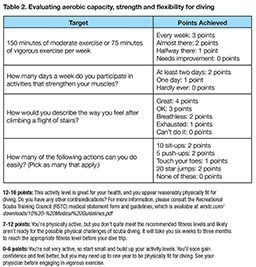Recreational scuba diving is generally categorized as moderate physical activity, but circumstances can make it high intensity. For reference, other examples of moderate activity are a brisk walk on a level surface, a recreational bike ride or a leisurely backstroke in the pool. High-intensity exercise includes activities such as open-water swimming and running a marathon. As with any exercise, it is important to honestly and accurately assess your fitness level before diving.
The American Heart Association and American College of Sports Medicine health guidelines offer useful considerations for medical history and cardiovascular health risk factors.
Major cardiac events (heart attack, surgery or other procedures), heart disease, heart failure and symptoms such as chest pains, dizziness or blackouts are all reasons to see a health-care provider before undertaking exercise of any kind. If you have multiple cardiovascular risk factors — such as high blood pressure, high cholesterol, diabetes or a family history of heart attacks — or you are simply a certain age (45 years old for men; 55 years old for women), a visit to your physician is recommended before diving. While you may not be aware of certain heart defects such as patent foramen ovale (a hole in your heart) until you have a problem during a dive, it’s important to take seriously any sign of possible cardiac problems. Immersion in water increases the volume of fluid in the core of your body, and this additional stress may compound preexisting problems.

If you have no indicators of cardiovascular problems and no relevant medical history, you may be able to use some simple tests at home to assess your fitness to dive. The three areas of concern for divers are aerobic capacity, strength and flexibility, all of which you can evaluate with the help of a few resources.
If your main concern is aerobic endurance, the 12-minute swim test developed by Kenneth H. Cooper, M.D., M.P.H., and detailed in his book The Aerobics Program for Total Well-Being is an excellent measure. All you need is a pool with a known length in yards and a partner with a stopwatch or clock to time you and track your distance. Begin by warming up for a few laps, then swim at a steady pace for 12 minutes using any stroke or rest time necessary, and cool down afterward. Compare the distance you achieve to the ratings in Table 1 to determine your overall endurance level.

Table 2 details a land-based test of aerobic capacity, strength and flexibility developed from recommendations by the U.S. Centers for Disease Control and Prevention and the U.K.’s National Health Service. Answer the questions honestly, and calculate your point total. The evaluation of your results is based on information from dive medicine experts. Even if you are generally healthy, a predominantly sedentary lifestyle may disguise your physical fitness level until you are challenged.
While you may feel comfortable with your fitness level after a self-assessment, it’s still important to consider whether you might be putting your health at risk by diving. The Recreational Scuba Training Council provides a form and guidelines that cover the necessary considerations for a diver. (This form is available through your training organization or online.) Diving is typically a moderate activity, but it does present unique risks. Being proactive about your own fitness will help keep you safe in the water.
| © Alert Diver — Q4 2018 |